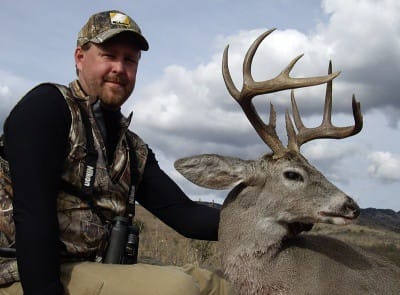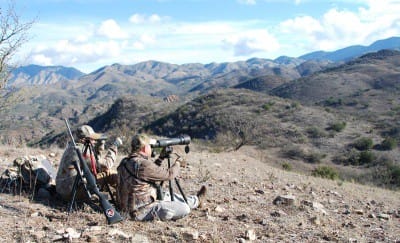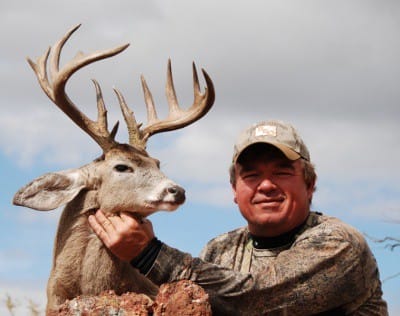Submitted By:
Tim Herald – USA Guest Author
 The diminutive Coue’s deer is one of those animals I have heard about for years but never given much thought to. After all, I am not a long-range shooter, the little deer don’t grow huge antlers, and I honestly just didn’t see what the big deal was.
The diminutive Coue’s deer is one of those animals I have heard about for years but never given much thought to. After all, I am not a long-range shooter, the little deer don’t grow huge antlers, and I honestly just didn’t see what the big deal was.
Not one to say ever or never, I was talking to my friend Brad Fulk about Gould’s turkeys, and he brought up his true passion, Coue’s. Brad is an outfitter from Arizona that conducts Gould’s and Coue’s hunts in Sonora and Chihuahua south of the border, and as he described the hunt for Sonoran whitetails, I was definitely intrigued. I know that Fulk’s Rio Sonora Outfitters has a great reputation for producing high scoring bucks, so eventually we set up a hunt for me to come and give it a try.
Fulk picked me up in Tucson, and we proceeded through the border with no problems at all. Our drive to camp was a little longer than usual as a torrential thunderstorm hammered us almost the entire way and through the night. I sure wasn’t expecting that in the desert environment, but what can you do?
Our first morning found us perched on a ridge glassing the side of a snow-covered mountain, and numerous smaller foothills and canyons. Fulk schooled me in glassing from binoculars on tripods and gridding areas for maximum efficiency. It didn’t take long for us to begin seeing deer, and it was evident that the rut was in full swing.
Every buck we saw was chasing a doe or fighting another buck, and I was really surprised at how many deer we could see. The magic number for trophy Coue’s bucks is generally accepted as 100 inches, and Boone and Crockett is 110. We saw a couple of 100-inchers that morning, but Fulk really targets 110-inch deer or larger for his clients.
A few hours into the hunt Brad spotted a deer that he thought was a potential shooter, but it disappeared behind a ridge. We packed up and made a mile hike to try to get a better look. On the way, we ran into five other bucks, but we never relocated the buck we were pursuing; so goes Coue’s hunting.
That afternoon and the second day was more of the same. We saw plenty of deer, some quality bucks, but nothing that really got Brad excited. The third morning, we hiked in to a high ridge that looked over a couple of miles of lower hills and canyons.

As the sun peaked over the eastern mountains, deer appeared everywhere. We saw bucks chasing does, making scrapes and rubbing mesquite trees in many different locations. About 8 a.m., Brad spotted a buck and doe a mile and a half away and called me over to set up my big spotting scope. I was carrying a Nikon EDG 20x60x85mm Fieldscope, and checking deer antlers at that range was no problem. Unfortunately, the buck disappeared into a canyon before we got to view him in the powerful scope.
For more than an hour, we vigilantly watched for the buck to emerge on either side of the canyon, but our efforts were in vain. Brad told me to stay put and keep my eyes on the canyon, and he was going to make a move to another high point that was perpendicular to where the buck went in. We would be able to see each other, so if either of us spotted the buck, we could signal the other to come over.
After an hour and a half, Fulk signaled me to come to his location close to a mile away. I packed up all my gear, and 45 minutes later I joined him on the opposite ridge. He said that the buck we were after was bedded about half a mile below and to our west. Brad said that when he first saw the buck, he got into a major fight with another big buck. He said he could hear them from where he was, and they crashed through brush and really had quite the battle.
Eventually the buck that was now bedded won the fight, and the other deer vacated the area. Fulk had kept tabs on him until I got there, and he showed me the deer through his spotting scope. He had 4 points on one side and 5 on the other, and there was no question that this was a shooter. Even though these small whitetails only weight about 85 to 90 pounds, when you see a big one, you know it. The antlers stand out on their small bodies just like a big Midwestern whitetail’s rack does on his 250-pound body. This guy was a no-brainer.
Slowly we stalked closer to the buck using the ridge to hide our movement for a few hundred yards, but eventually we had to cover some open ground. From our ridge, we made our way down the hill toward the buck using small oaks and junipers to block our approach wherever possible. After 150 yards, we ran out of room. The hillside dropped off in a sheer cliff, so this was the end of our stalk.
There was a gnarly old juniper on the edge of the cliff, and we crawled up to it and ranged the buck at 300 yards. That was it; I would have to make the shot from there. I am not a long-range shooter, but I had practiced quite a bit at 300 yards at my home range, so I felt like I could make the shot if I could get a steady rest.
I set up my shooting sticks and settled in, and my sight picture looked good. The buck was still bedded, and we decided we would wait for him to stand and give me a better target. I watched the buck lying there for more than a half hour, and I mentally prepared myself for the shot. I knew the kill zone on a 90-pound deer was small, and I had to be precise with my shot placement. I was nervous.
Finally, a small group of the ranch’s horses made their way toward the bedded buck, and I thought that my chance might be at hand. On cue, the buck spotted the horses and slowly stood. He was slightly quartering away, and he turned his head away and groomed his shoulder. As soon as he raised his head, Brad whispered, “Take him,” and I slowly squeezed the trigger.
As I came out of the recoil, I saw a white flash as the buck flipped and expired less than 10 yards from where I shot him. My bullet found its mark just behind the shoulder. We celebrated for a few minutes and then scoped out a route off our hill to where my prize lay. It was 1:30 p.m.
We finally reached my first Coue’s deer, and I was honestly blown away. He was a beautiful little gray deer, and his antlers were dark, heavy and looked huge on him. Brad was obviously pleased, and I knew from his reaction that we had taken a real trophy.
We were a long way back in, so we knew we had to skin the deer there and pack him out on our backs. It took us over an hour and a half to get back to the closest road with our over-laden packs. I checked my watch and saw that it was 6 p.m. The hunt had taken 10 hours from the time that Brad had initially spotted the buck.

My Coue’s gross scored 116 3/8 and netted right at 111. Shooting a B&C class deer far exceeded my wildest expectations, but the next day we had another huge surprise. Chris Ayers, another hunter in camp, took a buck that measured 132 4/8 inches with a 3-inch tine broken off. This was a deer of legendary proportions, and just to get to see it in the flesh was a real honor.
Coue’s deer may not be big in stature, but the hunting experience for these gray ghosts is anything but small. Glassing, hiking and precision shooting make this one of the greatest challenges a deer hunter can find. Don’t overlook a Coue’s hunt when planning your next adventure. You won’t be disappointed.
To book a quality hunt with this outfitter, go to www.riosonoraoutfitters.com



